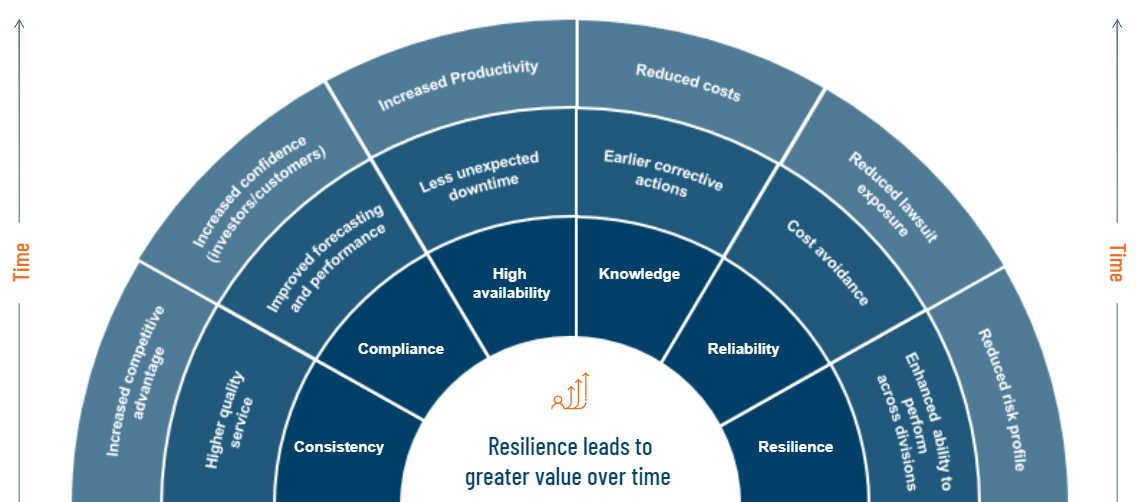In a volatile business environment, the concept of resilience has emerged as a cornerstone of strategic management. More than just a trendy concept, resilience should be ingrained as a key organizational goal, fostered through a comprehensive and continuous strategy. This strategy integrates a thorough understanding of the risk environment, enabling organizations to adapt and prosper when – not if – those risks were to materialize. These disruptions could be technological, operational or external threats. Ensuring rapid recovery and continuous business operations is crucial for enduring success. Key pillars of enterprise resilience include:
- Business resilience
- Cloud resilience
- Cyber resilience
- Data resilience
- Technology resilience
- Third-party resilience
Business resilience: Continuity in the face of adversity
Business resilience is the capability of an organization to plan for and adapt to disruptions while maintaining critical operations. This concept is holistic and should consider elements such as operational processes, workforce management and strategic planning. Businesses can develop resilience by aligning their strategic objectives with continuity planning, fostering a culture of adaptability and maintaining flexible operational processes.
What to do now:
- Align resilience needs identified as part of continuity planning to strategic objectives
- Evaluate your organizational structure and work with leaders to discuss how you can implement a more adaptable and agile environment
- Review and begin implementing leading business resilience practices, such as those discussed in this post, in a cohesive manner across the organization
Cloud resilience: Navigating the complexities of cloud computing
As organizations increasingly migrate to the cloud, cloud resilience has become a focal point for ensuring that cloud-based applications and services remain securely available and accessible during disruptions. Cloud resilience addresses unique challenges including dependency on cloud service providers, risks associated with data breaches, building for resilience or disaster recovery in the cloud, addressing multi-cloud strategies and enabling technology resilience by avoiding single points of failure.
What to do now:
- Evaluate the challenges and risks of cloud computing related to resilience
- Incorporate disaster recovery planning when developing cloud strategies
- Understand the benefits of multi-cloud strategies for resilience
Cyber resilience: Defending against evolving threats
Cyber resilience is the capability of an organization to prepare for, respond to and recover from cyberattacks. In a landscape where cyber threats are ubiquitous and continuously evolving, organizations must build robust defenses while also ensuring that they can quickly recover from breaches. Elements of a comprehensive cyber resilience strategy include threat intelligence, incident response planning, regular security assessments, the importance of employee training and the role of cybersecurity frameworks in enhancing resilience.
What to do now:
- Integrate threat intelligence and incident response processes to mitigate cyber risk
- Schedule regular security assessments and incorporate continuous improvement into everyday operations
- Incorporate cyber resilience practices into employee training
Data resilience: Protecting the lifeblood of the organization
Data is the lifeblood of modern organizations, making data resilience a critical component of any resilience strategy. This involves safeguarding data from loss, corruption or unauthorized access and ensuring that data can be quickly restored in a disruption. Data resilience includes leading practices for classification, data backup/ replication, the role of encryption and access controls, strategies for ensuring compliance with data protection regulations and how cloud technologies can enhance data resilience by providing scalable and secure storage solutions.
What to do now:
- Formalize practices for data backup and data recovery in case of an incident
- Ensure teams recognize the importance of encryption and access controls for data security
- Introduce compliance with data protection regulations to ensure data resilience
Technology resilience: Safeguarding the digital backbone
Technology resilience refers to an organization’s ability to sustain and recover its technological infrastructure and critical services during and after a significant disruption. In an age where digital transformation drives business growth, ensuring that IT systems, hardware, software, data and networks are resilient is crucial. Technology resilience requires strategies to maintain redundancy, implement robust disaster recovery plans, ensure technological innovations do not introduce new vulnerabilities, understand how automation and Artificial Intelligence (AI) can enhance technology resilience by predicting failures, and automate recovery processes with increased effectiveness.
What to do now:
- Take steps to understand how redundancy in IT systems impacts your organization’s resilience
- Introduce disaster recovery planning and implementation resilience practices
- Incorporate AI and automation in technology resilience efficiency
Third-party resilience: Strengthening the supply chain
In an interconnected world, organizations are heavily reliant on third-party vendors, suppliers and partners. Third-party resilience ensures organizations can continue to operate during disruptions without these external entities, thereby minimizing potential impact on the organization’s operations. Third-party resilience includes comprehensive risk assessment practices, contractual safeguards, minimizing consolidation risk in the supply chain and how ongoing monitoring and relationship management can mitigate risks associated with third party-reliant critical operations.
What to do now:
- Establish risk assessment and rigorous management of third-party dependencies
- Develop contractual safeguards and legal considerations for third-party resilience
- Recognize the importance of diversification and ongoing monitoring of third-party vendor resource providers
The value of resilience: A strategic advantage
The components of resilience are strategic investments that can drive significant value for organizations. By building resilience across business operations, cloud infrastructure, cybersecurity, data, technology and third-party relationships, organizations can achieve:
- Increased competitive advantage: Resilient organizations can continue to operate and even thrive when competitors falter, gaining market share and greater customer loyalty.
- Increased confidence (investors/customers): Demonstrating resilience builds trust among stakeholders, including investors and customers, leading to stronger relationships and increased market share and value.
- Increased productivity: Resilience minimizes downtime and disruptions, allowing employees to focus on their core responsibilities and maintain high productivity levels.
- Reduced costs: Proactively managing risks and building resilience can prevent costly disruptions, reduce the need for emergency expenditures and lower insurance premiums.
- Reduced lawsuit exposure: Ensuring business continuity and compliance reduces the risks of legal action from customers, partners and regulators.
- Reduced risk profile: A comprehensive resilience strategy lowers the organization’s overall risk profile, making it more attractive to investors and partners.

Building a resilient future
Resilience is not just about surviving; it’s about thriving in an increasingly threatening environment. As we navigate an increasingly complex and unpredictable world, organizations that prioritize resilience will be better positioned to protect their assets, maintain operations and capitalize on new opportunities. By enhancing understanding and essential implementation of these resilience leading practices, organizations can not only withstand crises but also emerge stronger and more competitive.
To learn more about our technology resilience solutions, contact us or download our Guide to Business Continuity and Resilience and refer to Achieving Resilience Starts at the Top.






